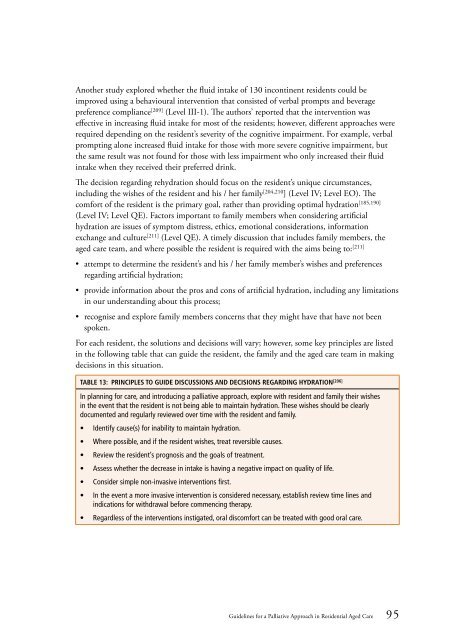Guidelines for a Palliative Approach in Residential Aged Care
Guidelines for a Palliative Approach in Residential Aged Care
Guidelines for a Palliative Approach in Residential Aged Care
Create successful ePaper yourself
Turn your PDF publications into a flip-book with our unique Google optimized e-Paper software.
Another study explored whether the fluid <strong>in</strong>take of 130 <strong>in</strong>cont<strong>in</strong>ent residents could be<br />
improved us<strong>in</strong>g a behavioural <strong>in</strong>tervention that consisted of verbal prompts and beverage<br />
preference compliance [209] (Level III-1). The authors’ reported that the <strong>in</strong>tervention was<br />
effective <strong>in</strong> <strong>in</strong>creas<strong>in</strong>g fluid <strong>in</strong>take <strong>for</strong> most of the residents; however, different approaches were<br />
required depend<strong>in</strong>g on the resident’s severity of the cognitive impairment. For example, verbal<br />
prompt<strong>in</strong>g alone <strong>in</strong>creased fluid <strong>in</strong>take <strong>for</strong> those with more severe cognitive impairment, but<br />
the same result was not found <strong>for</strong> those with less impairment who only <strong>in</strong>creased their fluid<br />
<strong>in</strong>take when they received their preferred dr<strong>in</strong>k.<br />
The decision regard<strong>in</strong>g rehydration should focus on the resident’s unique circumstances,<br />
<strong>in</strong>clud<strong>in</strong>g the wishes of the resident and his / her family [204,210 ] (Level IV; Level EO). The<br />
com<strong>for</strong>t of the resident is the primary goal, rather than provid<strong>in</strong>g optimal hydration [185,190]<br />
(Level IV; Level QE). Factors important to family members when consider<strong>in</strong>g artificial<br />
hydration are issues of symptom distress, ethics, emotional considerations, <strong>in</strong><strong>for</strong>mation<br />
exchange and culture [211] (Level QE). A timely discussion that <strong>in</strong>cludes family members, the<br />
aged care team, and where possible the resident is required with the aims be<strong>in</strong>g to: [211]<br />
• attempt to determ<strong>in</strong>e the resident’s and his / her family member’s wishes and preferences<br />
regard<strong>in</strong>g artificial hydration;<br />
• provide <strong>in</strong><strong>for</strong>mation about the pros and cons of artificial hydration, <strong>in</strong>clud<strong>in</strong>g any limitations<br />
<strong>in</strong> our understand<strong>in</strong>g about this process;<br />
• recognise and explore family members concerns that they might have that have not been<br />
spoken.<br />
For each resident, the solutions and decisions will vary; however, some key pr<strong>in</strong>ciples are listed<br />
<strong>in</strong> the follow<strong>in</strong>g table that can guide the resident, the family and the aged care team <strong>in</strong> mak<strong>in</strong>g<br />
decisions <strong>in</strong> this situation.<br />
Table 13: Pr<strong>in</strong>ciples to guide discussions and decisions regard<strong>in</strong>g hydration [206]<br />
In plann<strong>in</strong>g <strong>for</strong> care, and <strong>in</strong>troduc<strong>in</strong>g a palliative approach, explore with resident and family their wishes<br />
<strong>in</strong> the event that the resident is not be<strong>in</strong>g able to ma<strong>in</strong>ta<strong>in</strong> hydration. These wishes should be clearly<br />
documented and regularly reviewed over time with the resident and family.<br />
• Identify cause(s) <strong>for</strong> <strong>in</strong>ability to ma<strong>in</strong>ta<strong>in</strong> hydration.<br />
• Where possible, and if the resident wishes, treat reversible causes.<br />
• Review the resident’s prognosis and the goals of treatment.<br />
• Assess whether the decrease <strong>in</strong> <strong>in</strong>take is hav<strong>in</strong>g a negative impact on quality of life.<br />
• Consider simple non-<strong>in</strong>vasive <strong>in</strong>terventions first.<br />
• In the event a more <strong>in</strong>vasive <strong>in</strong>tervention is considered necessary, establish review time l<strong>in</strong>es and<br />
<strong>in</strong>dications <strong>for</strong> withdrawal be<strong>for</strong>e commenc<strong>in</strong>g therapy.<br />
• Regardless of the <strong>in</strong>terventions <strong>in</strong>stigated, oral discom<strong>for</strong>t can be treated with good oral care.<br />
<strong>Guidel<strong>in</strong>es</strong> <strong>for</strong> a <strong>Palliative</strong> <strong>Approach</strong> <strong>in</strong> <strong>Residential</strong> <strong>Aged</strong> <strong>Care</strong> 95
















